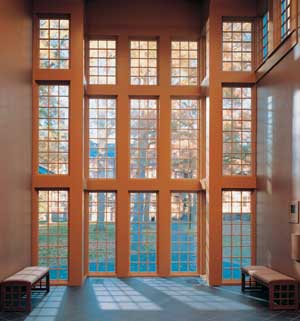Windows and Sustainability: An Environmental Perspective
 Daylight and views are required for at least 75 percent of all regularly occupied areas in order to achieve IEQ Credit 8.1. Courtesy of Pella Corporation |
|
Innovation and Design Process
Windows may contribute to points in this last major category. New technologies are continually introduced into the marketplace, as scientific research influences building design. This category recognizes projects for innovative building features.
Innovation in Design, Credit 1, describes how design teams can be awarded points for exceptional performance above LEED requirements and innovative performance in categories not addressed in the LEED Green Building Rating System. Credits 1.1 to 1.4, each worth one point for up to four independent measures, can identify proposed compliance requirements, submittals demonstrating compliance, and innovative design approaches to meet the requirements.
Windows can contribute to achieving this credit. Strategies that greatly exceed LEED requirements might include those with energy-efficient measures with extraordinary savings. Points for exemplary performance are available only when outcomes produce outstanding, measurable benefits.
Innovation strategies not addressed by existing LEED credits must demonstrate significant environmental and occupant benefits. For example, a visitors center showing substantial effort, such as an interactive display, web site, and video, would show a level of effort meriting an innovation credit.
LEED Accredited Professional, Credit 2 encourages design integration required for a LEED project to streamline the application and certification process. Credit 2, worth one point, requires at least one principal participant of the project team who successfully completed the LEED Accredited Professional (LEED-AP) exam. Windows do not typically help with this credit, but the accredited professional can integrate design, credits, and identify appropriate strategies.
Environmental Impacts of Window Frame Materials
Understanding the life cycle of building products is important for meeting sustainability goals. The following life cycle comparison of three common types of window framing materials, aluminum, vinyl, and wood, is based on eight evaluation categories: source material, renewable, recycled content, embodied energy, pollution produced, energy consumed, recyclable, and biodegradable. There is not yet much third-party research available on fiberglass windows, so this material cannot be fully addressed.
Primary Source of Raw Materials:Aluminum is made from bauxite. It is an abundant natural mineral with an approximate 300-year supply but is sourced primarily from locations outside the United States. Plastic or vinyl windows are made from fossil fuels, which, according to some sources, may have only a 50-year supply remaining. Wood comes from trees, which, if planting rates remain at current rates, will continue to increase in supply.
Renewable:Of the three window frame materials, aluminum, vinyl, and wood, only wood is derived from a rapidly renewable resource. According to the Forest Resources of the U.S (2002), the net volume of softwood on U.S. forestlands was 12 percent greater in 1997 than in 1953. When forests are properly managed, wood is a sustainable resource. The net volume of wood in U.S. forests is increasing, as a result of sustainable forest techniques. In 2001, the volume of softwood growth exceeded the volume of softwood removal by 36 percent.
|
||
Recycled Content: Recycled content is commonly included in windows made from aluminum and wood. Both extruded and roll-formed aluminum can contain recycled content without degrading the end product. Recycled wood is commonly used in wood window frames. Short wood pieces that are too small for sash parts are often finger jointed together to form lengths that can be used in wood window frames. The building industry continues to debate the amount of recycled content used in vinyl window production. According to an industry master specification system, most lineal extruders of vinyl use 100 percent virgin polyvinyl chloride (PVC) resins and do not recommend PVC resins containing recycled content.
Embodied energy refers to the amount of energy required to manufacture and supply a product, material, or source to the point of use. It includes all of the energy used to create one pound of a finished product, from raw material extraction, to transport, manufacturing, assembly, and building installation. Wood and recycled aluminum require the least amount of production energy.










